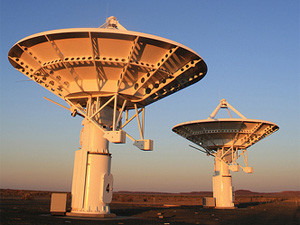
The Square Kilometre Array (SKA) project is a step closer to the start of construction on the world's largest telescope, after the teams who will be responsible for its final design were announced today.
A statement, released by the SKA organisation, says more than 350 scientists and engineers, representing 18 nations and drawn from nearly 100 institutions, universities and industries, have the challenging task of working on the critical detailed design phase, which will usher in the most sensitive and powerful telescope ever devised.
"This is a level of engagement only seen in revolutionary projects," says professor Phil Diamond, DG of the SKA Organisation. "That we have been able to pull together a team of some of the world's best experts, most prestigious institutions and major companies, reflects the passion and ambition of the scientific and engineering communities to work on an inspirational world-class project of the scale of the SKA."
The funding made available by the partners for this detailed design phase is EUR120 million.
During the year, the SKA Organisation sent out invitations to research organisations and industry partners around the globe to participate in the analysis and design of the components of the SKA during its three-year detailed design phase. This request for proposals included a conceptual design of the telescope, a work breakdown structure, a statement of the work required and additional reference documents.
As with other projects of this magnitude, the SKA has been broken down into various modules called "work packages". Each of these work packages will be managed by a consortium of international experts.
"Each element of the SKA is critical to the overall success of the project, and we certainly look forward to seeing the fruits of each consortium's hard work shape up over the coming years," says professor John Womersley, chairman of the SKA board.
"Now this multi-disciplinary team of experts has three full years to come up with the best technological solutions for the final design of the telescope, so we can start tendering for construction of the first phase in 2017 as planned. The directors of the SKA board feel the consortia selected represent some of the world's very finest scientists and engineers."
Each consortium has provided detailed management and verification plans, schedules, milestones and budgets for the various elements with which they have been tasked, says the statement.
The strategic aim of the SKA Organisation, which is coordinating the global effort, is that the work undertaken within each of the consortia is focused on these specific elements of the SKA project, and that their work will span the entire pre-construction period and meet critical design reviews along the way.
The consortia teams will be called upon to ensure their various elements integrate and interface as seamlessly as possible.
According to the SKA Organisation, the SKA telescope will provide a monumental increase over current scientific capabilities when operational and will be able to address some of humankind's greatest questions, such as our understanding of gravity, the nature of dark energy, the very formation of the universe and whether life exists elsewhere.
Share